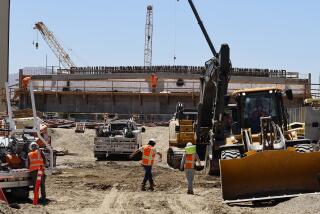State jobless rate rises to 6.2%
- Share via
SACRAMENTO — California’s unemployment rate hit 6.2% in March, the highest level in almost four years, spurred by a continuing downturn in construction and financial activities.
The Employment Development Department reported Friday that 1.13 million people were out of work last month, marking the state’s weakest economic performance since July 2004, when the jobless rate also stood at 6.2%.
Unemployment is up 1.2 percentage points from a year earlier, with 229,000 more Californians looking for work than in March 2007.
Since then, the job outlook has darkened as a largely housing-related slowdown has cut into the net worth of consumers, forcing them to cut back spending, economists said.
Tightfisted consumers have made life difficult for John Rodriguez. Two months ago, he lost his job at a furniture warehouse store that closed because of a lack of customers.
“A lot of companies are in shutdown mode right now, not to mention that it’s competitive fighting everyone else who’s getting laid off,” Rodriguez, 25, said during a fruitless visit to a state jobs office on Wilshire Boulevard near downtown Los Angeles. “I should be making money and spending it on entertainment, but I haven’t been able to enjoy myself at all.” He’s now living with his parents and feeling helpless.
March’s rise in unemployment, though not surprising, provides further evidence that California is “tipping into” a possibly prolonged recession, said Christopher Thornberg, the principal at Beacon Economics, a Los Angeles consulting and analysis firm.
“We are going to have a good old-fashioned consumer spending recession in 2008,” he said. “We only began to see a pullback in consumer spending the fourth quarter of last year. So, from that perspective, we have a long way to go.”
Rodriguez got plenty of company in March. The number of unemployed people rose by 84,000, even though the total of nonfarm jobs in California increased by 1,000 compared with February, the state said.
The rise in unemployment affected all of Southern California, with the worst effects in the Inland Empire. The rate in the Riverside-San Bernardino-Ontario area rose to 7.1%. It hit 5.8% in Los Angeles County and 4.6% in Orange County.
Although civilian employment in Los Angeles County decreased by 15,000, some sectors showed significant growth. Motion picture and sound recording jumped by 8,600 jobs as the entertainment industry recovered from the writers strike. The leisure and hospitality business also posted a recovery partially fueled by strong tourism spending by foreign visitors spending cheap dollars.
Statewide, the picture remained strongest in Northern California, which had a net increase of 19,800 jobs over the last year. Southern California had a net loss of 62,600 jobs for the same 12 months.
One of those victims, Erik Ayala, 27, of South Los Angeles, lost his medical billing job in October. He said he never expected to be out of work for so long. He’s been sending out 10 job applications a week and has been forced to rely on food stamps and his wife’s earnings.
“Sometimes I get to an interview and they’ve already filled the job,” Ayala said. “There are a lot of people looking for jobs out there.”
The uptick in people losing their jobs “means more bad news ahead for state and local [government] budgets,” said Stephen Levy, director of the Center for the Continuing Study of the California Economy in Palo Alto.
Next month, Gov. Arnold Schwarzenegger and state lawmakers must grapple with plunging tax revenue and a projected $8-billion-plus budget deficit as they prepare the state’s spending plan for the fiscal year beginning July 1.
Levy noted that California’s unemployment rate is the third-highest in the country, trailing Michigan with 7.2% and Alaska with 6.7%. California is doing worse than Pennsylvania and Ohio, Levy said, two Rust Belt states that have figured prominently in the presidential primary elections because of their manufacturing job losses.
The news about California’s economy is not all bad, the Schwarzenegger administration said. “Today’s numbers show that the downturn in the residential construction and financial activities sectors continues to be a drag on the economy, but seven of California’s 11 major industry sectors continue to show job growth,” said Victoria Bradshaw, secretary of the Labor and Workforce Development Agency.
“We’re focusing our resources on helping people affected by the national housing slump move into jobs in industries that are growing.”
The governor’s efforts could help save construction jobs by shifting carpenters and other journeymen from residential developments to public works projects, said Michael Bernick, a former Employment Development Department director and research fellow with the Milken Institute in Los Angeles.
“The more than $40 billion in infrastructure bonds, approved by voters in November 2006, are beginning to come on line,” he said.
--
Times staff writer Tiffany Hsu contributed to this report.
More to Read
Inside the business of entertainment
The Wide Shot brings you news, analysis and insights on everything from streaming wars to production — and what it all means for the future.
You may occasionally receive promotional content from the Los Angeles Times.











